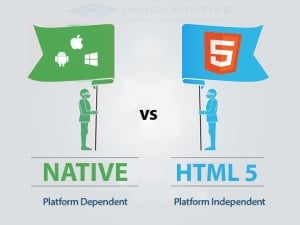Native vs HTML5 apps – The best option to drive your Enterprise Mobile strategy

This blog attempts to throw some light on some of the pros and cons of using native vs HTML5 apps from technical, functional and business perspectives. Any app that is directly installed onto a device, normally from its associated app store is called as a native app, though a native app can have HTML5 elements. One of the key disadvantages of native apps is that they are platform dependent, which means any app developed for iPhone can work on an iPhone only and not on an Android device.
On the other hand, a web app delivered through an HTML5 enabled browser may be called as an HTML5 app. This implies instead of downloading your app from the app store, a user would access his/her browser and navigate to a URL to use your app.
HTML5 for web development is mostly liked by the developers, since it leverages familiar programming languages like HTML, Javascript and CSS.
Though it seems enticing to use HTML5 at first instance considering its prime benefits, however, HTML5 lacks maturity in having enough set of web standards to fully deliver on its promises. Some of the key shortcomings include missing APIs and weaker UIs as compared to native apps, apart from having difficulty to route ads into HTML5 sites.
Benefits of native apps
- Superior performance: A native app has full access to a phone’s hardware resources and the app also interacts directly with the phone without the mediation of a web browser. This way native apps provide superior performance, which is more visible when rendering graphics and animation.
- Minimized development efforts: Developers can easily leverage platform SDKs to create native apps, which ensures easier and minimized development efforts – requires talented and experienced professionals who can understand the programming models.
- Better distribution: Native apps provides a better distribution mechanism, wherein they can be distributed directly through relevant app stores. App stores serves as a stupendous distribution channel that not only makes app installation and updates easier, but can also help reduce the marketing costs through app stores’ built in discovery features.
- Superior monetization: Since native apps are associated with app stores, they can take the benefit of store’s built-in monetization features like one-click payments.
- Superior user experience: Native apps offer better execution experience with respect to certain core features like accelerometer, camera, calendar, GPS, microphone, etc., as compared to HTML5 apps on various devices.
Shortcomings of native apps
- Increased development and costs: The overall development time might be considerably greater than an equivalent HTML5 app, as developers need to build separate apps for each platform. This also enhances costs since development efforts for varied platforms needs mastery over different languages and development environments. App developers themselves tend to be on a higher cost range, in contrast to their HTML5/JavaScript counterparts.
- Higher maintenance costs: When development costs are more, it is quite obvious that maintenance costs are also on a higher scale. A business might solicit the services of a separate iOS, Android and Windows phone developers to keep its apps up and running that directly diminishes their profits.
- Restriction on app store content: Every app distributed through app store must comply with strict content guidelines.
- App store fees: High app store fees may eat into your profit margins that is really daunting, in addition to the higher development and maintenance costs of native apps.
Some of the pros and cons of HTML5 apps are outlined as follows:
Pros of HTML5 Apps
- Platform independent: This is a major benefit of using HTML5 apps as compared to native apps. Irrespective of whether your users are on Android, iOS or Windows Phone, all of them can access your app, since they need only a web browser.
- Easier updates: Native apps takes longer time for updates – the user has to download each update individually. On the other hand, HTML5 apps support centralized updates, wherein every time the user accesses the app through his/her browser, he/she views the latest version of your app, eliminating additional download requirements.
- Faster development: As HTML5 apps are developed using the HTML, CSS, JavaScript, and server-side languages (such as ASP.NET), it cuts down the development time. This is because there are already vast libraries for these languages (such as jQuery and JavaScript) and a vast group of trained developers.
- Cuts down developer costs: As HTML5 apps are built on comparatively simpler technologies like HTML5 and JavaScript, you can easily hire affordable HTML5 developers, as compared to native app developers.
- No content restrictions: As HTML5 apps need to require approval from a closed app store, they can carry whatever content you need.
- No fees: When you deliver your apps directly through the browser, you can cut down the app store costs, which means you save almost 30% of your store fees.
- Distribution through app store: New frameworks such as Phnegap and Trigger.io have simplified the distribution problem substantially bundling up HTML5 apps as native apps. These bundled apps can then be distributed through the app store.
Cons of HTML5 Apps
- Inferior performance: Since an HTML5 app has limited access to a phone’s hardware, it results in inferior performance, especially when dealing with heavy graphics. Some of the new platforms like Famo.us are trying to solve this problem.
- Device fragmentation: Device fragmentation within browsers is a real thing. Varied devices might render the same app quite differently. This implies your developers might require extensive testing and refining to get the UI right, particularly when working on more complex apps.
- Technical restrictions: HTML5 apps lacks complete access to a device’s features and events. This poses a serious challenge on what you can do with an HTML5 app. Apart from that, the UI options for HTML5 apps are also limited.
- Limited monetisation opportunities: A native app can earn substantial revenue through direct app sales and in-app purchases. This monetization option is not available for HTML5 apps, which is particularly challenging if you want to offer your apps for “free”.
So which is the best option to choose?
It is difficult to decide which one is best, since both native and HTML5 apps have their respective flavors. The type of app you choose is totally dependent on your requirements, core expertise, budget and the type of human resources you can hire.
If you would like to request a demo of Innovapptive's Native, HTNL5 or Hybrid apps, please click on the link. Alternatively, if you would like to discuss with an Innovapptive solution expert, you can reach out to us by emailing us at sales@innovapptive.com or you can reach a sales representative at (713) 275-1804.

See It In Action
Schedule a personalized demo to see how our solutions can help your business thrive.
- 29-09-2025
Your Ultimate Guide to Connected Worker
In the rapidly evolving industrial landscape, maximizing plant efficiency and ensuring optimal...
- 20-08-2025
Building the future of Industrial Operations with Innovapptive and AWS
Most manufacturers have already gone digital. Yet business outcomes haven’t moved in step. Many...
- 22-04-2025
The $3.6B Unlock: Solving the Chemical Industry’s Labor Crisis and EBITDA Pressure in One Move
“Constraints don’t slow innovation—they force it.”


